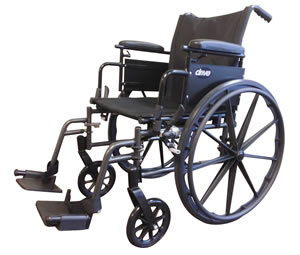Product Spotlight
Keeping Things on a Roll
The Cruiser X4 brings the combination of low weight and competitive bidding-friendly price point that Drive delivered with its Cruiser 3 to a K4 chair.
- By David Kopf
- Jan 01, 2014
It pays to make the most of established momentum. Such is the case with the Cruiser X4, Drive Medical’s new entry in the K4 manual wheelchair category. Already enjoying success with the Cruiser 3, it’s lightweight K3 chair, Drive sought to design an offering for the K4 category that addressed the hear-and-now needs of providers and patients alike.

Drive’s newest entry is the Cruiser X4, which aims to combine price and features in a lightweight chair that weighs in under Medicare’s 34-pound threshold for K4 chairs.
“We have some interesting paradoxes forming,” says Mike Serhan, executive principal with Drive Medical. “We have the government wanting to cut reimbursement as much as possible. And with competitive bidding, we’re coming to a point where we are having to take more and more out of a product, or the providers in how they service the patient. It doesn’t make it right for the patient. The patient still needs a product that works.”
Moreover, a third variable as mixed into Drive’s product-development paradox. It had to satisfy the top criteria of all manual chair users: weight.
“You can ask any provider, when asking the patient what is right for them in a wheelchair, it’s always going to be light weight. It has to be lightweight,” Serhan notes.
So Drive tried to combine the three: something that was price competitive for providers, while meeting the needs for the end user in the way of being lightweight, while offering solid features and good quality. This lets providers make margin and continue to earn a living and the patient can have something that is going to deliver the care and features they need.
Fortunately, Drive had a good foundation to build on. The company’s Cruiser 3, a lightweight K3 chair, turned into one of Drive’s best-selling products specifically because it mixed those components of price and delivering what the patient wanted. However, Drive didn’t have a product in the K4 category that was tailored to what providers needed.
No Skimping on Features
So Drive began developing a product with that pricing “prime directive” in mind. The result is something that likely exceeds expectations in the features department. For starters, the chair features an adjustable, on-chair depth seat. The chair can be adjusted up to two inches deeper, to accommodate a support surface. The chair is also hemi available, so that it can be adjusted to a low-hemi position, a position between a hemi and a standard, and a standard height position. The height adjustments for the chair is all made via a push button (adjustments on the front caster are made with a tool), and there is a quick release on the rear wheel.
That simple adjustability helps when the user or caregiver needs to put the chair in the car. Simple height adjustment along with a quick release on the rear wheel means the chair is more likely to be brought along on outings.
“A lot of the issues with injuries that occur after people get [DME] products are compliance issues,” Serhan explains. “They get the product and it is either too heavy to use, or too ugly to use, it’s cumbersome, or whatever the case may be. So, we try to solve with this with the quick release to make it easier for the user.”
The chair features a three-position front caster and three-position rear caster. Also, users can create dump on the chair by moving the axle up one half position in the rear, and leave the front axle position to create decline in the chair where the patient’s knees are higher than the back to protect users that are prone to falling forward out of the chair.
Along with that, the caster journal has an adjustable angle to prevent wheel flutter that could arise when the chair is in a dump position. This ensures the caster angle is always at a 90-degree angle to the floor.
Getting all the features into a low price point and low weight in the process turned into a puzzle, Serhan adds. The solution was mixing materials to his Medicare’s 34-pound threshold.
“What we had to do was work with different metals on different parts of the chair to get it into that lightweight K4 category,” he says.
So the chair incorporates a blend of carbon steel and aluminum in the right places. A chip resistant finish is then added for durability and looks.
Cruiser X4
Drive Medical
www.drivemedical.com
(877) 224-0946
This article originally appeared in the January 2014 issue of HME Business.
About the Author
David Kopf is the Publisher HME Business, DME Pharmacy and Mobility Management magazines. He was Executive Editor of HME Business and DME Pharmacy from 2008 to 2023. Follow him on LinkedIn at linkedin.com/in/dkopf/ and on Twitter at @postacutenews.